Analysis of Structural and Magnetic Phase Transitions in Multiferroic Y-Type Hexaferrite Systems by Means of Transverse Magnetic Susceptibility
Abstract
:1. Introduction
2. Materials and Methods
3. Results
3.1. Ba2−xSrxCo2Fe12O22 System (BSCFO)
3.2. Ba2−xSrxZn2Fe12O22 System (BSZFO)
4. Conclusions
Author Contributions
Funding
Data Availability Statement
Acknowledgments
Conflicts of Interest
References
- Aharoni, A.; Frei, E.H.; Shtrikman, S.; Treves, D. The reversible susceptibility tensor of the Stoner-Wohlfarth model. Bull. Res. Counc. Isr. Sect. A Math. Phys. Chem. 1957, 6A, 215–238. [Google Scholar]
- Pareti, L.; Turilli, G. Detection of singularities in the reversible transverse susceptibility of an uniaxial ferromagnet. J. Appl. Phys. 1987, 61, 5098–5101. [Google Scholar] [CrossRef]
- Richter, H.J. Determination of magnetic anisotropy of magnetically hard materials. J. Appl. Phys. 1990, 67, 3081–3087. [Google Scholar] [CrossRef]
- Poddar, P.; Wilson, J.L.; Srikanth, H.; Farrell, D.F.; Majetich, S.A. In-plane and out-of-plane transverse susceptibility in close-packed arrays of monodisperse Fe nanoparticles. Phys. Rev. B 2003, 68, 214409. [Google Scholar] [CrossRef]
- Sollis, P.M.; Bissell, P.R.; Mayo, P.I.; Chantrell, R.W.; Gilson, R.G.; O’Grady, K. Characterization of the dispersion process using transverse susceptibility measurements. J. Magn. Magn. Mater. 1993, 120, 94–96. [Google Scholar] [CrossRef]
- Zimmerman, G.; Hempel, K.A. Transverse susceptibility of uniaxial multidomain particles. IEEE Trans. Magn. 1992, 28, 3126–3128. [Google Scholar] [CrossRef]
- ElBidweihy, H.; Smith, R.D.; Hughes, H. Parametric amplification of reversible transverse susceptibility in single domain magnetic nanoparticles. AIP Adv. 2019, 9, 045031. [Google Scholar] [CrossRef]
- Kalappattil, V.; Das, R.; Phan, M.H.; Srikanth, H. Roles of bulk and surface magnetic anisotropy on the longitudinal spin Seebeck effect of Pt/YIG. Sci. Rep. 2017, 7, 13316. [Google Scholar] [CrossRef]
- Chandra, S.; Biswas, A.; Datta, S.; Ghosh, B.; Raychaudhuri, A.K.; Srikanth, H. Inverse magnetocaloric and exchange bias effects in single crystalline La0:5Sr0:5MnO3 nanowires. J. Magn. Magn. Mater. 2013, 24, 505712. [Google Scholar]
- Woods, G.T.; Poddar, P.; Srikanth, H. Observation of charge ordering and the ferromagnetic phase transition in single crystal LSMO using rf transverse susceptibility. J. Appl. Phys. 2005, 97, 10C104. [Google Scholar] [CrossRef]
- Frey Huls, N.A.; Bingham, N.S.; Phan, M.H.; Srikanth, H.; Stauffer, D.D.; Leighton, C. Transverse susceptibility as a probe of the magnetocrystalline anisotropy-driven phase transition in Pr0.5Sr0.5CoO3. Phys. Rev. B 2011, 83, 024406. [Google Scholar] [CrossRef]
- Kimura, T. Magnetoelectric hexaferrites. Annu. Rev. Condens. Matter Phys. 2012, 3, 93–110. [Google Scholar] [CrossRef]
- Zhai, K.; Wu, Y.; Shen, S.; Tian, W.; Cao, H.; Chai, Y.; Chakoumakos, B.C.; Shang, D.; Yan, L.; Wang, F.; et al. Giant magnetoelectric effects achieved by tuning spin cone symmetry in Y-type hexaferrites. Nat. Commun. 2017, 8, 519. [Google Scholar] [CrossRef]
- Stimphil, E.; Nagesetti, A.; Guduru, R.; Stewart, T.; Rodzinski, A.; Liang, P.; Khizroev, S. Physics considerations in targeted anticancer drug delivery by magnetoelectric nanoparticles. Appl. Phys. Rev. 2017, 4, 021101. [Google Scholar] [CrossRef]
- Bai, Y.; Zhang, W.; Qiao, L.; Zhou, J. Low-fired Y-type hexagonal ferrite for hyper frequency applications. J. Adv. Ceram. 2012, 1, 100–109. [Google Scholar] [CrossRef]
- Ueda, H.; Tanaka, Y.; Nakajima, H.; Mori, S.; Ohta, K.; Haruki, K.; Hirose, S.; Wakabayashi, Y.; Kimura, T. Magnetic structure and effect of magnetic field on its domain structure in magnetoelectric Ba1.3Sr0.7CoZnFe11AlO22. Appl. Phys. Lett. 2016, 109, 182902. [Google Scholar] [CrossRef]
- Yang, Y.T.; Wang, L.Y.; Shen, L.J.; Zhou, W.P.; Song, Y.Q.; Lv, L.Y.; Wang, D.H.; Cao, Q.Q.; Du, Y.W.; Zhang, Y.J.; et al. Electric-field control of magnetization reversal in a Y-type hexaferrite. Solid State Commun. 2014, 178, 54–58. [Google Scholar] [CrossRef]
- Choi, B.; Kwon, S.; Lee, S.; Park, C.B.; Shin, K.W.; Kim, K. Fe and Co NMR studies of magnetoelectric Co2 Y-type hexaferrite BSCFAO. J. Phys. Condens. Matter 2018, 30, 065802. [Google Scholar] [CrossRef] [PubMed]
- Chmiel, F.P.; Prabahakaran, D.; Steadman, P.; Chen, J.; Fan, R.; Johnson, R.D.; Radaelli, P.G. Magnetoelectric domains and their switching mechanism in a Y-type hexaferrite. Phys. Rev. B 2019, 100, 104411. [Google Scholar] [CrossRef]
- Khanduri, H.; Chandra Dimri, M.; Kooskora, H.; Heinmaa, I.; Viola, G.; Ning, H.; Reece, M.J.; Krustok, J.; Stern, R. Structural, dielectric, magnetic, and nuclear magnetic resonance studies of multiferroic Y-type hexaferrites. J. Appl. Phys. 2012, 112, 073903. [Google Scholar] [CrossRef]
- Lee, H.B.; Chun, S.H.; Shin, K.W.; Jeon, B.; Chai, Y.S.; Kim, K.; Schefer, J.; Chang, H.; Yun, S.; Joung, T.; et al. Heliconical magnetic order and field-induced multiferroicity of the Co2Y-type hexaferrite Ba0.3Sr1.7Co2Fe12O22. Phys. Rev. B 2012, 86, 094435. [Google Scholar] [CrossRef]
- Pullar, R.C. Hexagonal ferrites: A review of the synthesis, properties and applications of hexaferrite ceramics. Prog. Mater. Sci. 2012, 57, 1191–1334. [Google Scholar] [CrossRef]
- Hernández-Gómez, P.; Martín-González, D.; Torres, C.; Muñoz, J.M. Broadband transverse susceptibility in multiferroic Y-type hexaferrite Ba0.5Sr1.5Co2Fe2O22. J. Magn. Magn. Mater. 2019, 476, 478–482. [Google Scholar] [CrossRef]
- Figueroa, A.I.; Bartolomé, J.; Garcia del Pozo, J.M.; Arauzo, A.; Guerrero, E.; Téllez, P.; Bartolomé, F.; García, L.M. Low temperature radio-frequency transverse susceptibility measurements using a CMOS oscillator circuit. J. Magn. Magn. Mater. 2012, 324, 2669–2675. [Google Scholar] [CrossRef]
- Cho, K.L.; Rhee, C.H.; Kim, C.S. The crystal structure and magnetic properties of Ba2−xSrxCo2Fe12O22. J. Appl. Phys. 2014, 115, 17A523. [Google Scholar]
- Xu, W.; Yang, J.; Shen, Y.; Bai, W.; Zhang, Y.; Liu, J.; Tang, K.; Wang, Z.; Duan, C.; Tang, X.; et al. Magnetocaloric effect in multiferroic Y-type hexaferrite Ba0.5Sr1.5Zn2(Fe0.92Al0.08)12O22. AIP Adv. 2014, 4, 067122. [Google Scholar] [CrossRef]
- Figueroa, A.I.; Bartolomé, J.; García, L.M.; Bartolomé, F.; Arauzo, A.; Millán, A.; Palacio, F. Magnetic Anisotropy of Maghemite Nanoparticles Probed by RF Transverse Susceptibility. Phys. Procedia 2015, 75, 1050–1057. [Google Scholar] [CrossRef]
- Nikzad, A.; Ghasemi, A.; Tehrani, M.K.; Gordani, G.R. Correlation between structural features and microwave analysis of substituted Sr-Co2 Y ceramic nanoparticles. J. Supercond. Nov. Magn. 2016, 29, 1657–1664. [Google Scholar] [CrossRef]
- Chang, Y.; Zhai, K.; Chai, Y.; Shang, D.; Sun, Y. Room-temperature magnetoelectric effects in multiferroic Y-type hexaferrites. J. Phys. D Appl. Phys. 2018, 51, 264002. [Google Scholar] [CrossRef]
- Hernández-Gómez, P.; Martín-González, D.; Torres, C.; Muñoz, J.M. Broadband transverse susceptibility in multiferroic Y-type hexaferrite Ba0.5Sr1.5Zn2Fe12O22. J. Magn. Magn. Mater. 2020, 506, 166808. [Google Scholar] [CrossRef]
- Wang, G.; Cao, S.Y.; Hu, S.; Wang, X.; Feng, Z.; Kang, B.; Chai, Y.; Zhang, J.; Ren, W. Magnetic field controllable electric polarization in Y-type hexaferrite Ba0.5Sr1.5Co2Fe12O22. J. Appl. Phys. 2015, 118, 094102. [Google Scholar] [CrossRef]
- Nakajima, T.; Tokunaga, Y.; Matsuda, M.; Dissanayake, S.; Fernandez-Baca, J.; Kakurai, K.; Taguchi, Y.; Tokura, Y.; Arima, T. Magnetic structures and excitations in a multiferroic Y-type hexaferrite BaSrCo2Fe11AlO22. Phys. Rev. B 2016, 94, 195154. [Google Scholar] [CrossRef]
- Kocsis, V.; Nakajima, T.; Matsuda, M.; Kikkawa, A.; Kaneko, Y.; Takashima, J.; Kakurai, K.; Arima, T.; Kagawa, F.; Tokunaga, Y.; et al. Magnetization-polarization cross-control near room temperature in hexaferrite single crystals. Nat. Commun. 2019, 10, 1247. [Google Scholar] [CrossRef] [PubMed]
- Kocsis, V.; Kaneko, Y.; Tokunaga, Y.; Tokura, Y.; Taguchi, Y. Enhanced Stability of the Multiferroic Phase in Cr-Doped Y-Type Hexaferrite Single Crystals. Phys. Rev. Appl. 2022, 18, 024050. [Google Scholar] [CrossRef]
- Mohammed, I.; Mohammed, J.; Kende, A.U.; Wara, A.M.; Aliero, Y.A.; Magawata, U.Z.; Umar, A.A.; Srivastava, A.K. Review on Y-type hexaferrite: Synthesis, characterization and properties. Appl. Surf. Sci. Adv. 2023, 16, 100416. [Google Scholar] [CrossRef]
- Kimura, T.; Lawes, G.; Ramirez, A.P. Electric Polarization Rotation in a Hexaferrite with Long-Wavelength Magnetic Structures. Phys. Rev. Lett. 2005, 94, 137201. [Google Scholar] [CrossRef] [PubMed]
- Kocsis, V.; Nakajima, T.; Matsuda, M.; Kikkawa, A.; Kaneko, Y.; Takashima, J.; Kakurai, K.; Arima, T.; Tokunaga, Y.; Tokura, Y.; et al. Stability of multiferroic phase and magnetization-polarization coupling in Y-type hexaferrite crystals. Phys. Rev. B 2020, 101, 075136. [Google Scholar] [CrossRef]
- Momozawa, N.; Yamaguchi, Y.; Takei, H.; Mita, M. Magnetic Structure of (Ba1-xSrx)2Zn2Fe12O22(x=0–1.0). J. Phys. Soc. Jpn. 1985, 54, 771–780. [Google Scholar] [CrossRef]
- Kamba, S.; Goian, V.; Savinov, M.; Buixaderas, E.; Nuzhnyy, D.; Maryško, M.; Kempa, M.; Bovtun, V.; Hlinka, J.; Knížek, K.; et al. Dielectric, magnetic, and lattice dynamics properties of Y-type hexaferrite Ba0.5Sr1.5Zn2Fe12O22: Comparison of ceramics and single crystals. J. Appl. Phys. 2010, 107, 104109. [Google Scholar] [CrossRef]
- Zhang, M.; Yin, L.; Liu, Q.; Kong, X.; Zi, Z.; Dai, J.; Sun, Y. Magnetic properties and magnetodielectric effect in Y-type hexaferrite Ba0.5Sr1.5Zn2-xMgxFe11AlO22. J. Alloys Compd. 2017, 725, 1252–1258. [Google Scholar] [CrossRef]
- Planes, A.; Castán, T.; Saxena, A. Thermodynamics of multicaloric effects in multiferroic materials: Application to metamagnetic shape-memory alloys and ferrotoroidics. Philos. Trans. R. Soc. A 2016, 374, 20150304. [Google Scholar] [CrossRef] [PubMed]
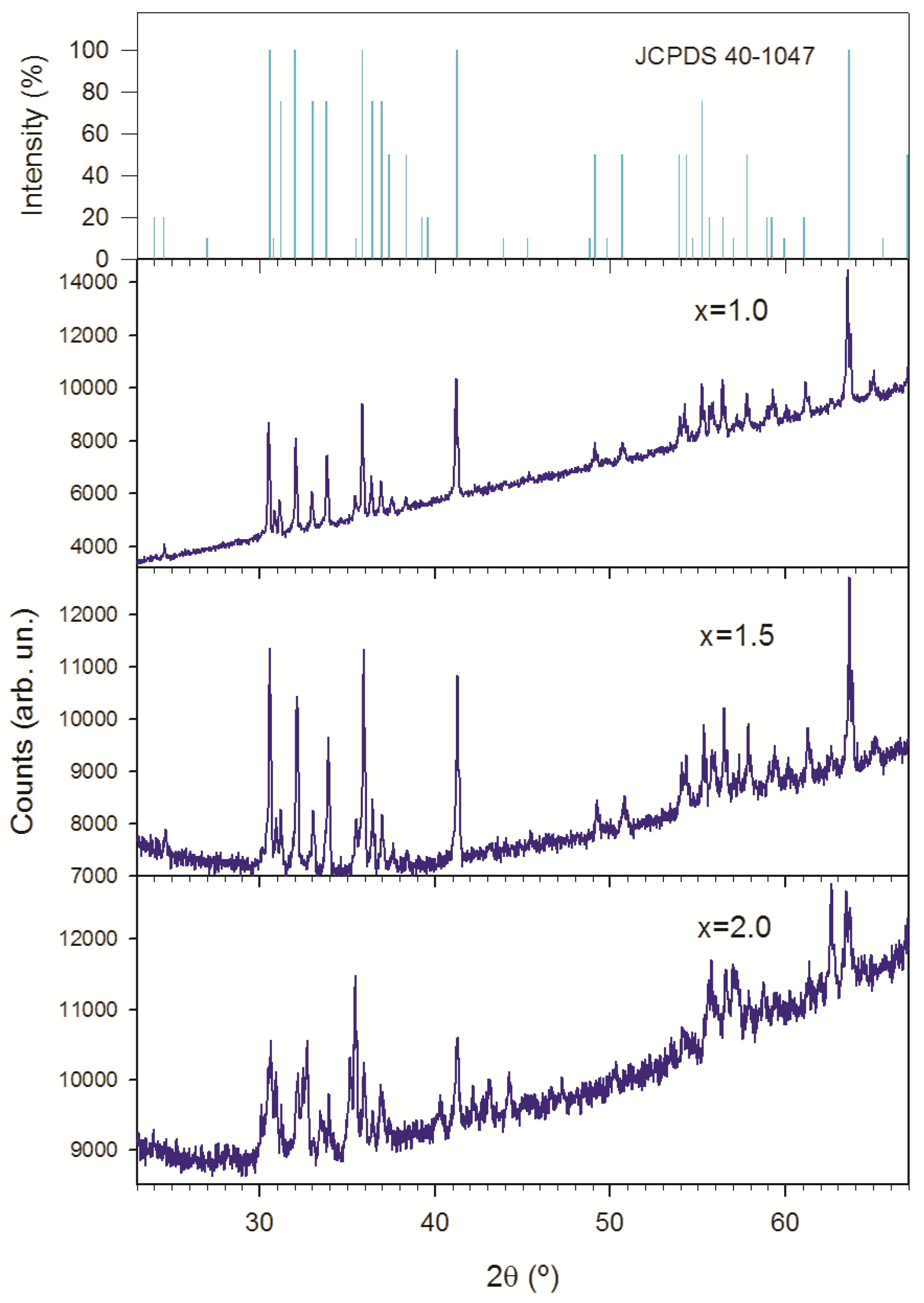
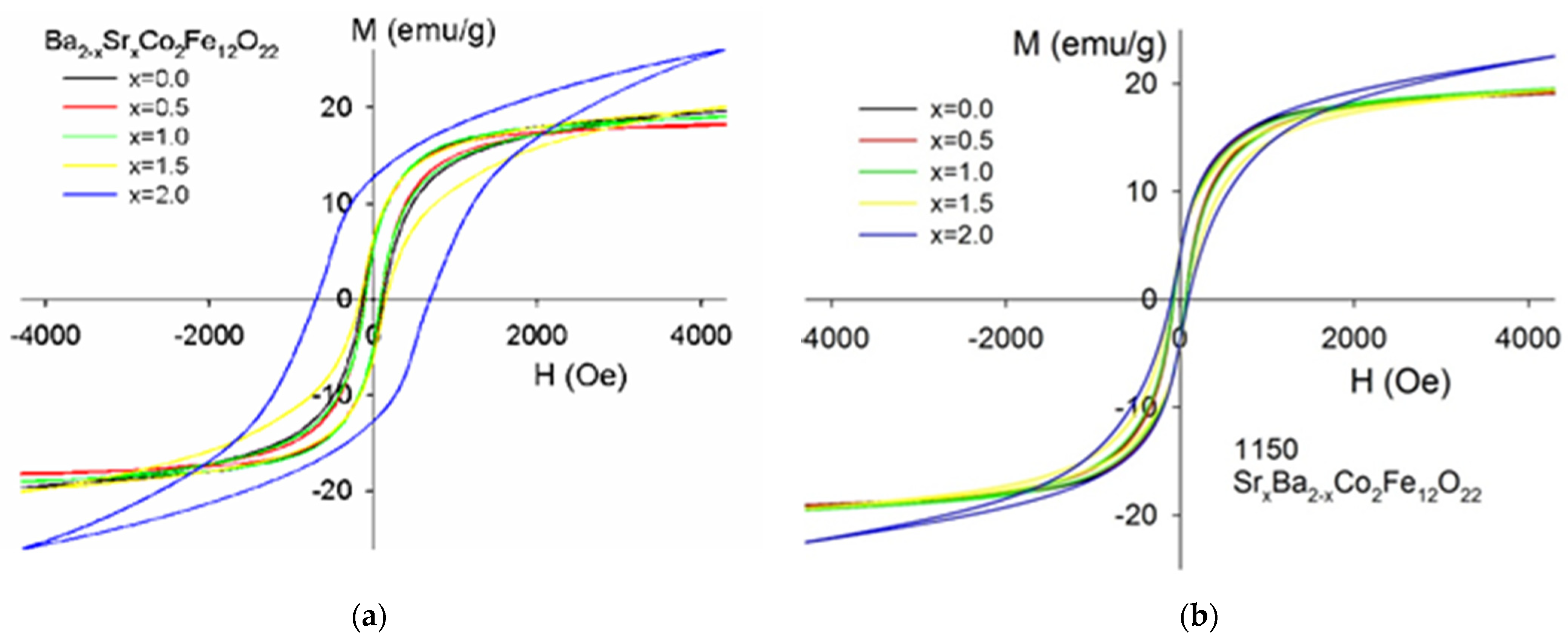
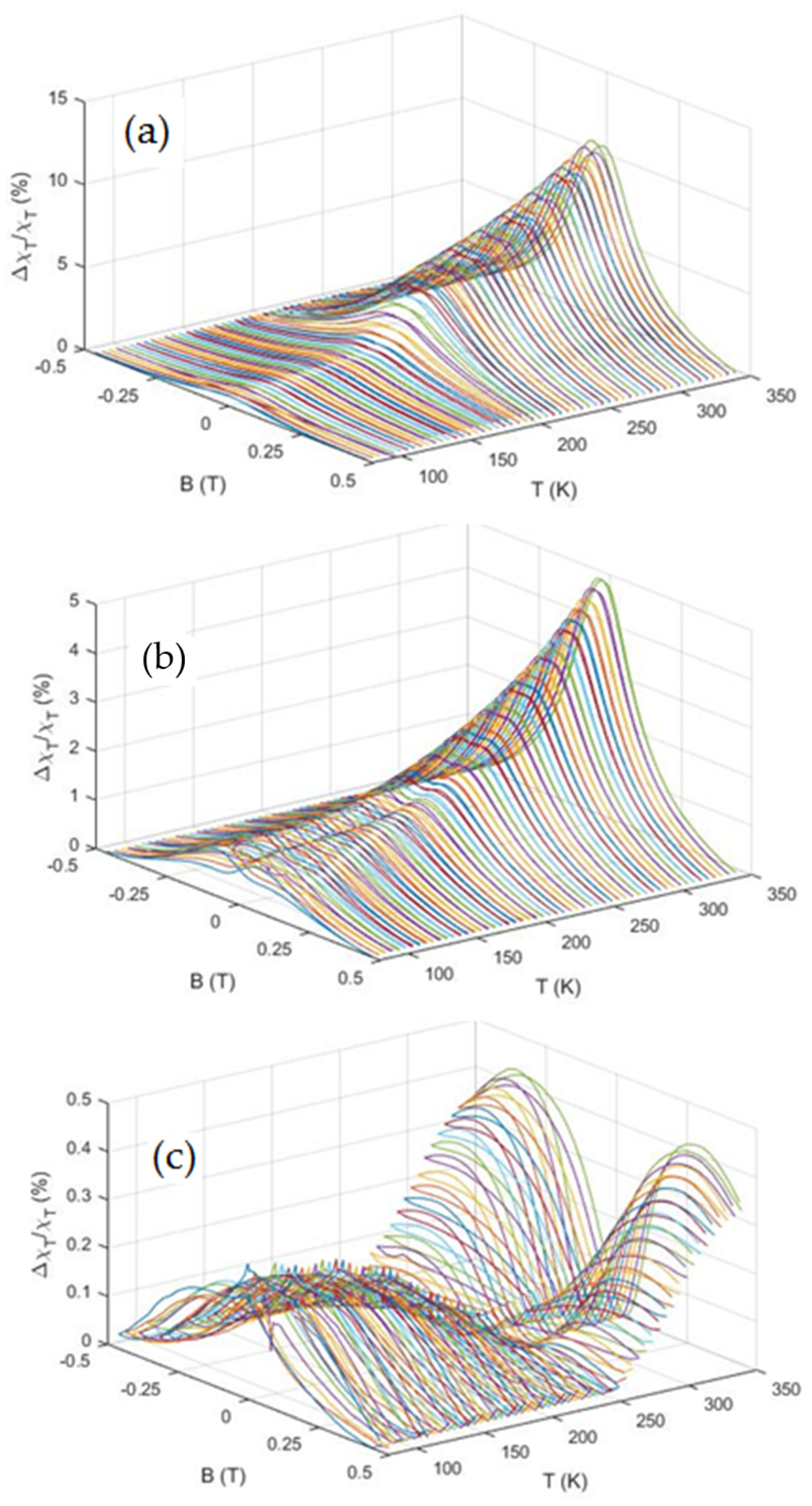
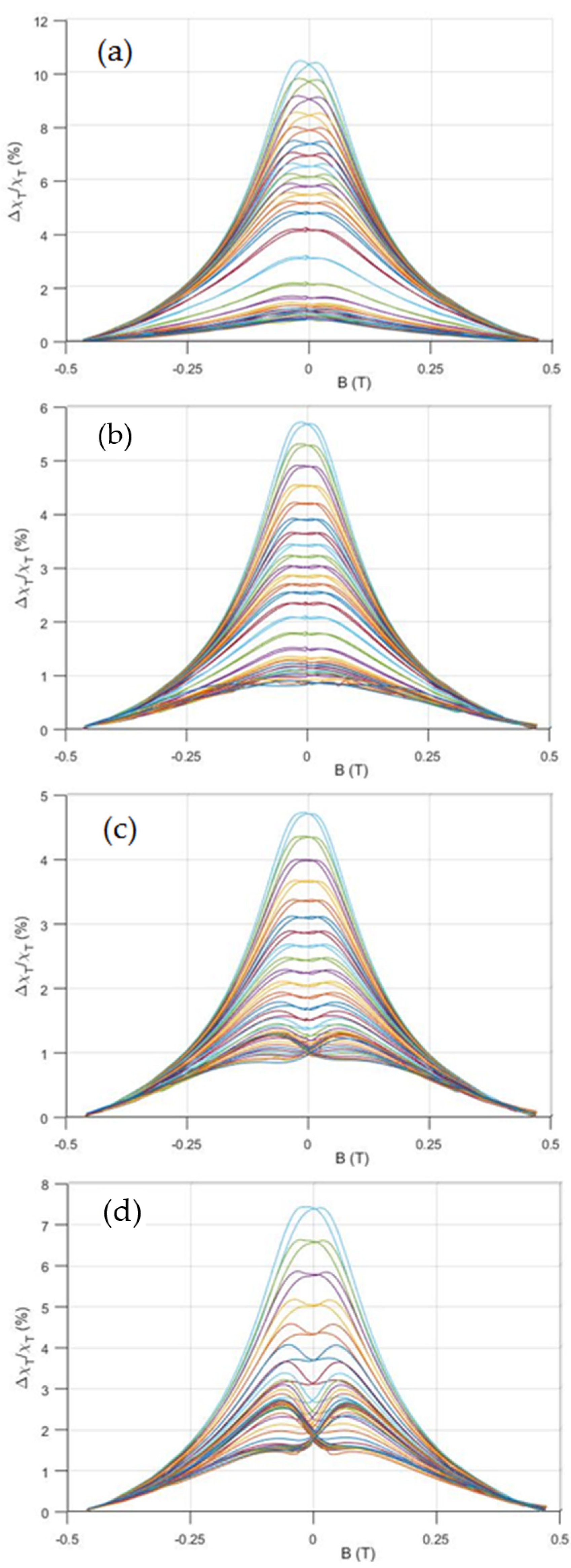


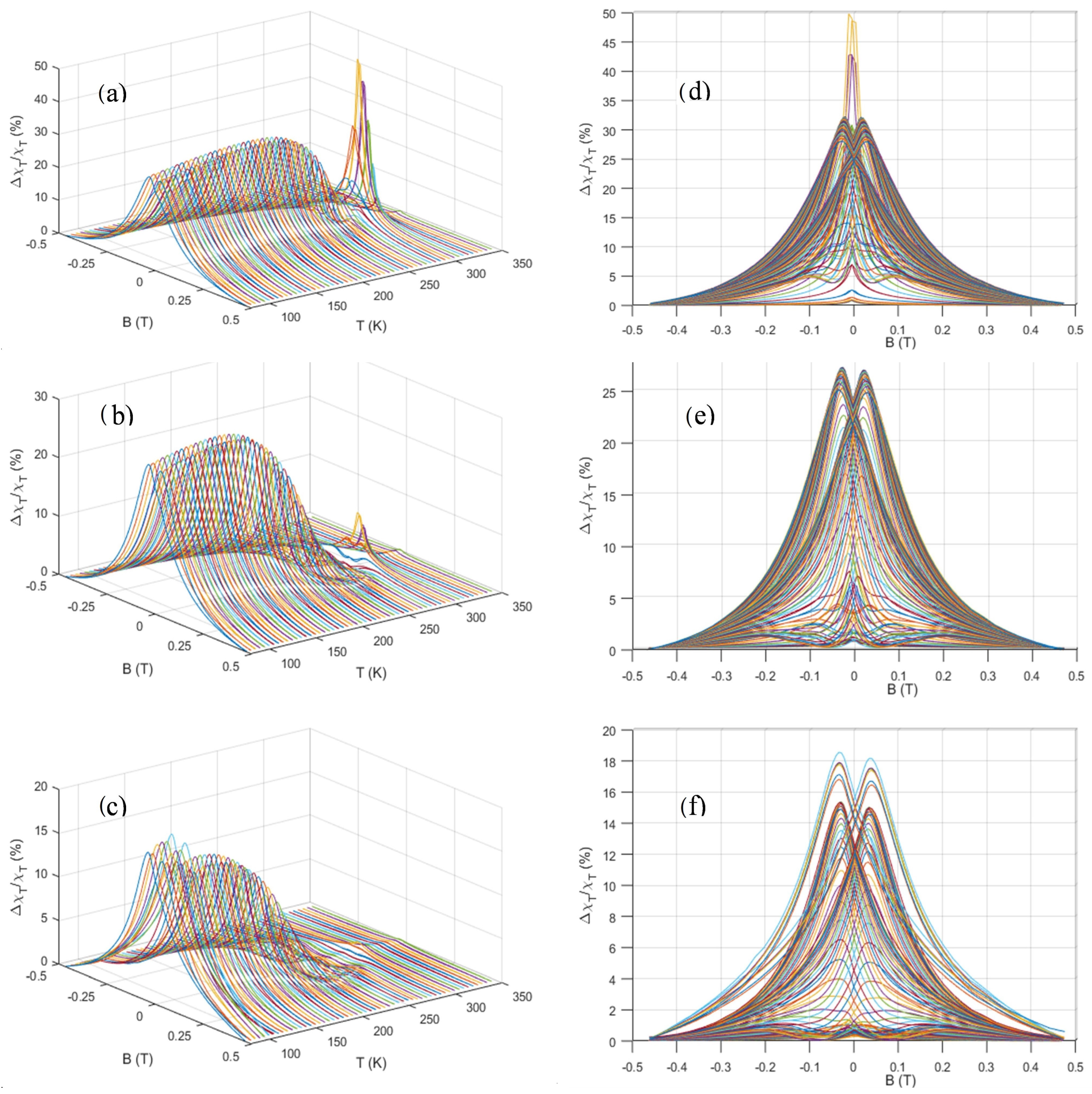

| Substitution Rate | Sintering Temperature | Ms (emu/g) | Mr (emu/g) | Hc (Oe) |
|---|---|---|---|---|
| x = 0.0 | 1050 °C | 19.65 | 5.9 | 129 |
| 1150 °C | 19.10 | 4.4 | 75 | |
| 1250 °C | 20.95 | 2.9 | 40 | |
| x = 0.5 | 1050 °C | 18.25 | 5.4 | 103 |
| 1150 °C | 19.15 | 4.1 | 66 | |
| 1250 °C | 19.80 | 3.0 | 47 | |
| x = 1.0 | 1050 °C | 19.10 | 5.2 | 95 |
| 1150 °C | 19.50 | 4.1 | 70 | |
| 1250 °C | 29.75 | 3.7 | 61 | |
| x = 1.5 | 1050 °C | 20.10 | 6.3 | 158 |
| 1150 °C | 19.35 | 4.6 | 104 | |
| 1250 °C | 31.45 | 3.9 | 61 | |
| x = 2.0 | 1050 °C | 26.15 | 12.7 | 695 |
| 1150 °C | 22.55 | 4.1 | 101 | |
| 1250 °C | 37.35 | 5.6 | 71 |
Disclaimer/Publisher’s Note: The statements, opinions and data contained in all publications are solely those of the individual author(s) and contributor(s) and not of MDPI and/or the editor(s). MDPI and/or the editor(s) disclaim responsibility for any injury to people or property resulting from any ideas, methods, instructions or products referred to in the content. |
© 2025 by the authors. Licensee MDPI, Basel, Switzerland. This article is an open access article distributed under the terms and conditions of the Creative Commons Attribution (CC BY) license (https://creativecommons.org/licenses/by/4.0/).
Share and Cite
Hernández-Gómez, P.; Bernardo, Ó.; Muñoz, J.M. Analysis of Structural and Magnetic Phase Transitions in Multiferroic Y-Type Hexaferrite Systems by Means of Transverse Magnetic Susceptibility. J. Compos. Sci. 2025, 9, 53. https://doi.org/10.3390/jcs9020053
Hernández-Gómez P, Bernardo Ó, Muñoz JM. Analysis of Structural and Magnetic Phase Transitions in Multiferroic Y-Type Hexaferrite Systems by Means of Transverse Magnetic Susceptibility. Journal of Composites Science. 2025; 9(2):53. https://doi.org/10.3390/jcs9020053
Chicago/Turabian StyleHernández-Gómez, Pablo, Óscar Bernardo, and José María Muñoz. 2025. "Analysis of Structural and Magnetic Phase Transitions in Multiferroic Y-Type Hexaferrite Systems by Means of Transverse Magnetic Susceptibility" Journal of Composites Science 9, no. 2: 53. https://doi.org/10.3390/jcs9020053
APA StyleHernández-Gómez, P., Bernardo, Ó., & Muñoz, J. M. (2025). Analysis of Structural and Magnetic Phase Transitions in Multiferroic Y-Type Hexaferrite Systems by Means of Transverse Magnetic Susceptibility. Journal of Composites Science, 9(2), 53. https://doi.org/10.3390/jcs9020053






